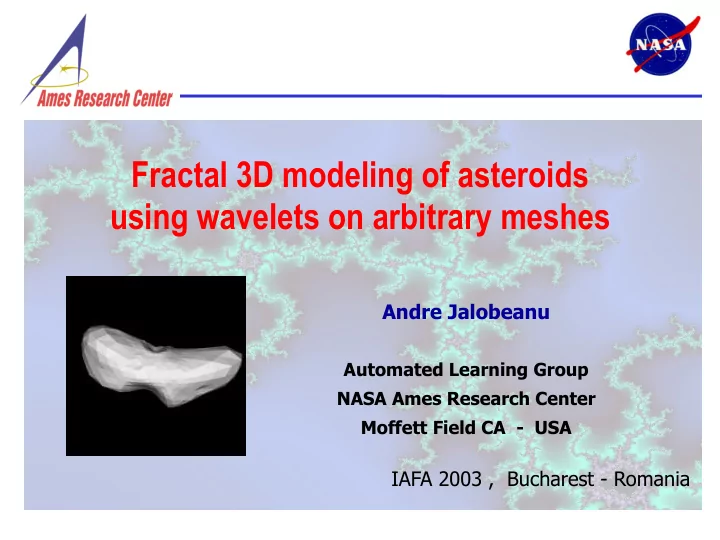

Fractal 3D modeling of asteroids using wavelets on arbitrary meshes Andre Jalobeanu Automated Learning Group NASA Ames Research Center Moffett Field CA - USA IAFA 2003 , Bucharest - Romania
Summary • Fractal appearance of asteroids • What tool to use to study them? • Wavelets on meshes with arbitrary topology – Topology, geometry and regularity – Subdivision meshes & wavelet transform • Local scale / local direction • Wavelet transform of 433 Eros – scale invariance • A new multiscale model for fractal surfaces • Applications
Fractal appearance of asteroids
What tool to use? Check statistical self-similarity : first compute the power spectrum of the object. • Quasi-planar surfaces: Fast Fourier Transform • Spherical surfaces: spherical harmonics • Arbitrary surfaces (highly irregular sampling): ? Wavelets on subdivided meshes spectrum: feature size / scale
Topology, geometry and regularity Topological support Set of sites (vertices) + neighborhood system Regularity = neighborhood regularity Semi-regular triangular mesh : 5 or 6 neighbors geometry Geometry 3D point associated to each site topology The object can have an irregular geometry, but we define the wavelets on the semi-regular topological support. wavelets topology
Subdivision meshes uniform subdivision … Original mesh Subdivided mesh, level 1 A new topological vertex is created on each edge Each triangle is replaced by 4 smaller triangles ideal framework to define a multiresolution approach
Vertex prediction Geometric subdivision : vertex creation by prediction Prediction of a vertex at level j+1 using 8 neighbor vertices m at level j : interpolation scheme [Sweldens-Schroeder]
Wavelets on subdivided meshes Wavelet coefficients at level j+1 = vertices at level j+1 – prediction from level j represent the details at level j+1 Vertices even odd prediction – approximation details
Multiresolution analysis of 433 Eros Approximations : a 1 … a n Coarse approximations of the 3D surface (fine to coarse) Details : d 1 … d n differences between two successive approximations
Local scale topological • x scaling geometry support • y scaling • skew local deformation 1 Details = absolute geometric variations (regardless of the local geometry) define a local scale
Local direction Wavelet details are 3D vectors normal + parallel decomposition sampling geometric irregularity detail actual vertex at level j+1 m
Statistical self-similarity Amplitude spectrum of 433 Eros (NEAR laser altimetry data) log σ (mean amplitude σ (r) = σ 0 r -q of normal detail fractal exponent coefficients) q=1.12 fractal dimension D=2.38 - log r ( local scale)
A new multiscale model • Adaptive scale-invariant Gaussian model on : acts as a smoothness prior (Bayesian inference) local scales geometric details = spatially adaptive Gaussian random variables parameters 3D analog to the 2D fractional Brownian motion (using Fourier coefficients instead of wavelet coefficients) that efficiently describes the power spectrum of natural images • � Statistical model of w // : sampling regularity prior
Applications • 3D object reconstruction from multiple images: – Asteroids (~uniform albedo, spherical topology) – Planetary surfaces (unknown albedo, planar/spherical topo.) • Simultaneous localization and mapping • Spacecraft localization + recursive reconstruction of the object surface (approach or flyby) • Multi-sensor data fusion (optical, radar, altimetry) • Fractal geometry and synthetic images: – Generate synthetic photo-realistic surfaces – Compute reflectance functions for natural objects
General 3D surface reconstruction Geometry Images (optical, radar, altimetry, etc.) Albedos Cameras Light sources
Asteroid surface reconstruction • Many images available (various orientations, distances) • The direction of the light source (Sun) is known • ~ known camera parameters • Albedo ~ constant Infer the asteroid surface from N calibrated images
� � Conclusion • The proposed wavelet transform has a linear complexity, is critically sampled and works for meshes of arbitrary topology • Coefficient decomposition and local scale estimate • Statistical self-similarity of 433 Eros checked by computing the amplitude spectrum of the geometry • New model for natural surfaces, many applications • Extension: support = irregular geometric mesh, data = scalar potential ⇒ study big spherical objects such as planets
Recommend
More recommend